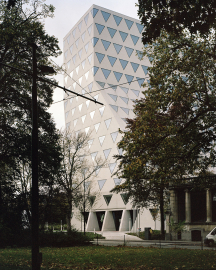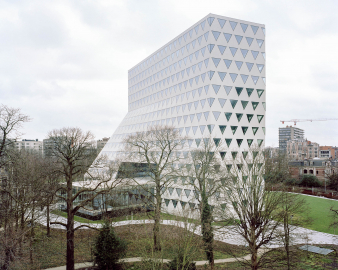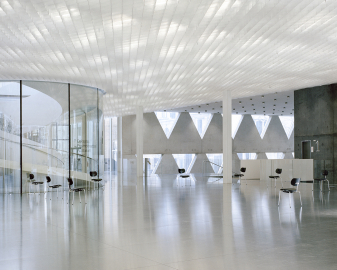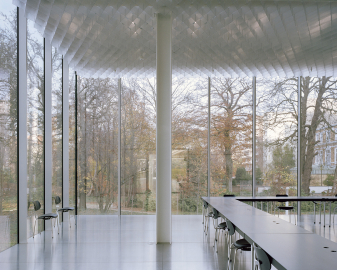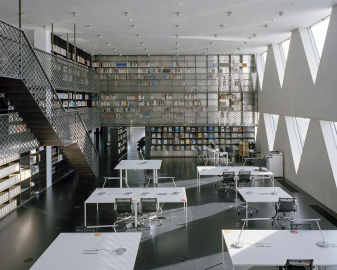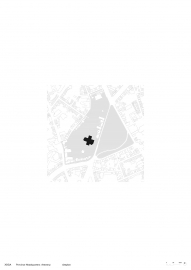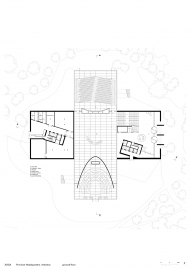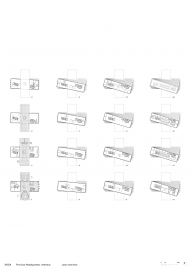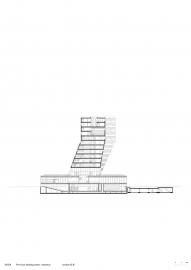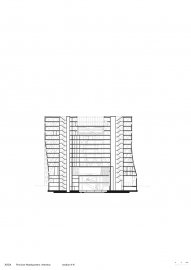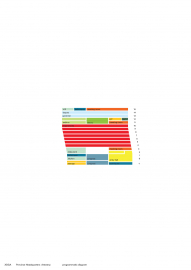Province Headquarters
The new Province Headquarters are conceived as a free-standing, compact construction combining congress functions in the entrance pavilion and office programs in the crossing tower. The publicly accessible parkland around the building is the result of the merging of smaller, fragmentary parks in the area and is part of a larger belt of green spaces.
The building combines its main administrative office floors with a public congress facility.
The transparent congress pavilion, parallel to the street, consists of an auditorium, the council chamber and a large open event and exhibition space, connected through the central steel helicoidal stairs.
The restaurant on the second floor edges the large terrace, covered by the office tower.
In between the twisting office floors and the top floors that are reserved for the elected representatives of the Province, lies the double-height library room with its large provincial archive and art storage.
The new building is deliberately set free in the surrounding park hiding the underground parking lot. Traversed by concrete walkways and bike lanes, the green rolling landscape reconnects the surrounding neighbourhoods.
The new building replaces a complex of modernist building volumes that used to occupy the entire site and that couldn’t be adapted to today’s sustainability standards. As the Antwerp city centre has few public green surfaces, the transformation of the site from a merely private, mineral and infrastructural area into a public garden is a crucial requirement of the competition brief. Surrounded by fragments of public green, the parcel is key to the formation of a larger, coherent park. Another – contradictory - demand was to maintain a more recent representational pavilion, which was positioned as an obstacle in between the fragments.
By situating the full program in a compact volume across the pavilion, this frontage is cut up and the main entrance is brought close to the street. This large volume, however, divides the park in a front and a back garden. Finally, by rotating the plan around one of its corners as it climbs up, the building shifts towards the centre; existing neighbouring buildings are respected and a sculptural form emerges. The pavilion building is at last replaced by a glazed volume to house the congress and exhibition part of the program
The building is conceived as a bridge structure over and across the pavilion. At the centre of the plan one large steel truss spans from one core to the other. Two more trusses are integrated in the concrete side walls and their triangulation defines the form of the window openings, ideal when it comes to balancing daylight access and overheating. The opaque tower façade is clad with circular, white glass mosaic while the pavilion is a fully transparent box in the park.
Throughout the building raw but refined materials are used as finish.
All walls are smooth white and black load-bearing concrete, cast on site. The floors of the congress pavilion are clad with untreated aluminium tiles, where the ceiling is fitted with a polycarbonate structure hiding the techniques and dispersing the light. The main council chamber is surrounded by white leather quilted walls.
The office’s raised technical floors are covered in green carpet, while the thermally activated concrete ceiling provides heating and cooling through the exchange with the BTES field below the underground parking.
The library, with its black rubber floor, is organised within an exposed steel filigree structure.

